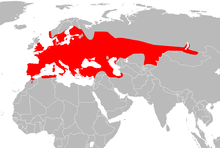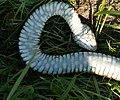Grass snake
| Grass snake | |
|---|---|

| |
| Scientific classification | |
| Domain: | Eukaryota |
| Kingdom: | Animalia |
| Phylum: | Chordata |
| Class: | Reptilia |
| Order: | Squamata |
| Suborder: | Serpentes |
| Family: | Colubridae |
| Genus: | Natrix |
| Species: | N. natrix
|
| Binomial name | |
| Natrix natrix | |

| |
| Natrix natrix range map | |
| Synonyms | |
The grass snake (Natrix natrix), sometimes called the ringed snake or water snake, is a Eurasian non-venomous snake. It is often found near water and feeds almost exclusively on amphibians. The barred grass snake, Natrix helvetica, was split off as a separate species in 2017.
Etymology
The name natrix is probably derived from the Latin nare or natare "to swim"; it means "something grammatically feminine which swims".
Subspecies
Many subspecies are recognized, including:[2]
- Natrix natrix algirus (fide Sochurek, 1979)
- Natrix natrix astreptophora (Seoane, 1885)
- Natrix natrix calabra Vanni & Lanza, 1983
- Natrix natrix cypriaca (Hecht, 1930)
- Natrix natrix fusca Cattaneo, 1990
- Natrix natrix gotlandica Nilson & Andrén, 1981
- Natrix natrix natrix (Linnaeus, 1758)
- Natrix natrix persa (Pallas, 1814)
- Natrix natrix schweizeri L. Müller 1932
- Natrix natrix scutata (Pallas, 1771)
Natrix natrix helvetica (Lacépède, 1789) was formerly treated as a subspecies, but following genetic analysis it was recognised in August 2017 as a separate species, Natrix helvetica, the barred grass snake. Four other subspecies were transferred from N. natrix to N. helvetica, becoming N. helvetica cettii, N. helvetica corsa, N. helvetica lanzai and N. helvetica sicula.[3]
Description

The grass snake is typically dark green or brown in colour with a characteristic yellow collar behind the head, which explains the alternative name ringed snake. The colour may also range from grey to black, with darker colours being more prevalent in colder regions, presumably owing to the thermal benefits of being dark in colour. The underside is whitish with irregular blocks of black, which are useful in recognizing individuals.[4] Weight is about 240 g (8 oz).[citation needed]
Distribution
The grass snake is widely distributed in mainland Europe, ranging from mid Scandinavia to southern Italy. It is also found in the Middle East and northwestern Africa. British grass snakes were thought to belong to the subspecies N. n. helvetica, though this is now recognised as a separate species.[3]
This species was considered to be one of only three snakes to occur in Great Britain, but the grass snakes in Great Britain have now been reidentified as barred grass snake Natrix helvetica, any records of N. natrix in Britain are now considered to have originated from imported specimens.[3]
Ecology
Feeding

Grass snakes prey mainly on amphibians, especially the common toad and the common frog, although they may also occasionally eat ants and larvae. Captive snakes have been observed taking earthworms offered by hand, but dead prey items are never taken.[5] The snake will search actively for prey, often on the edges of water, using sight and sense of smell (using Jacobson's organ). They consume prey live without using constriction.
Habitat
Grass snakes are strong swimmers and may be found close to fresh water, although there is evidence individual snakes often do not need bodies of water throughout the entire season.[5]
The preferred habitat appears to be open woodland and "edge" habitat, such as field margins and woodland borders, as these may offer adequate refuge while still affording ample opportunity for thermoregulation through basking. Pond edges are also favoured and the relatively high chance of observing this secretive species in such areas may account for their perceived association with ponds and water.
Grass snakes, as with most reptiles, are at the mercy of the thermal environment and need to overwinter in areas which are not subject to freezing. Thus, they typically spend the winter underground where the temperature is relatively stable.
Reproduction
As spring approaches, the males emerge first and spend much of the day basking in an effort to raise body temperature and thereby metabolism. This may be a tactic to maximise sperm production, as the males mate with the females as soon as they emerge up to two weeks later in April, or earlier if environmental temperatures are favourable. The leathery-skinned eggs are laid in batches of eight to 40 in June to July and hatch after about 10 weeks. To survive and hatch, the eggs require a temperature of at least 21 °C (70 °F), but preferably 28 °C (82 °F), with high humidity. Rotting vegetation, such as compost heaps, are preferred locations. The young are about 18 centimetres (7 in) long when they hatch and are immediately independent.
Migration
After breeding in summer, snakes tend to hunt and may range widely during this time, moving up to several hundred metres in a day.[5] Prey items tend to be large compared to the size of the snake, and this impairs the movement ability of the snake. Snakes which have recently eaten rarely move any significant distance and will stay in one location, basking to optimize their body temperature until the prey item has been digested. Individual snakes may only need two or three significant prey items throughout an entire season.
Ecdysis (moulting)
Ecdysis occurs at least once during the active season. As the outer skin wears and the snake grows, the new skin forms underneath the old, including the eye scales which may turn a milky blue/white colour at this time — referred to as being 'in blue'. The blue white colour comes from an oily secretion between the old and new skins; the snake's coloration will also look dull, as though the animal is dusty. This process affects the eyesight of the snakes and they do not move or hunt during this time; they are also, in common with most other snakes, more aggressive. The outer skin is eventually sloughed in one piece (inside-out) and normal movement activity is resumed.
Defence
Not being venomous, the snake's main defence is to produce a garlic-smelling fluid from the anal glands, or to feign death (thanatosis) by becoming completely limp.[6] They may also perform an aggressive display in defence, hissing and striking without opening the mouth. They rarely bite in defence. They may also secrete blood (autohaemorrhage) from the mouth and nose whilst playing dead.[7] When caught they often regurgitate the contents of their stomachs.
Grass snakes display a rare but known defensive behavior involving raising the front of the body and flattening the head and neck so that it resembles a cobra's hood, although the geographic ranges of grass snakes and of cobras overlap very little. However, the fossil record shows that the extinct European cobra Naja romani occurs in Miocene-aged strata of France, Germany, Austria, Romania, and Ukraine and thus overlapped with Natrix species including the extinct Natrix longivertebrata, suggesting that the grass snake’s behavioral mimicry of cobras is a fossil behavior, although it may avail against predatory birds which migrate to Africa for the winter and encounter cobras there.[8]
Protection and threats
The species has various predator species, including corvids, storks, owls and perhaps other birds of prey, foxes, and the domestic cat. In England, grass snakes are protected under the Wildlife and Countryside Act 1981 and cannot be harmed or traded without a licence, although they may legally be captured and kept in captivity. In Denmark, it is also protected,[9] as all five species of reptiles were protected in 1981.
Two of the subspecies are considered critically endangered: N. n. cetti (Sardinian grass snake) and N. n. schweizeri.[1] In 2007, the grass snake was included on the updated UK Biodiversity Action Plan as a species in need of conservation and greater protection.[10]
Mythology
Baltic people
In the mythology of the Baltic people, the grass snake (Lithuanian: žaltys, Latvian: zalktis, zaltis) is seen as a sacred animal. It was frequently kept as a pet, living under a married couple's bed or in a special place near the hearth. Supposedly, snakes ate food given to them by hand.[11]
After the Christianization of Lithuania, the grass snake still retained some mythological significance. In spite of the serpent's symbolic meaning as a symbol of evil in Christianity, in Latvia there were various folk beliefs, dating even to the late 19th century, that killing grass snakes might bring grave misfortune or that an injured snake will take a revenge on the offender. The ancient Baltic belief of grass snakes as household spirits transformed into a belief that there is a snake (known or not to the inhabitants) living under every house; if it leaves, the house will burn down.[12] Common Latvian folk sayings include "who kills a grass snake, kills his happiness" and "when the Sun (Saule) sees a dead grass snake, she cries for 9 days".[13]
Well-known literary works based on these traditions include Eglė the Queen of Serpents and the Latvian folk fairytale "The grass snake's bride" (Zalkša līgava). These works include another common theme in Baltic mythology: that grass snakes wear crowns (note grass snake's yellow spots) and that there is a king of snakes who wears a golden crown. In some traditions the king of snakes changes every year; he drops his crown in spring and the other snakes fight for it (possibly based on mating of grass snakes).[14]
Today grass snakes hold a meaning of house blessing among many Latvians. One tradition is to put a bowl of milk near a snake's place of residence, although there is no evidence of a grass snake ever drinking milk.[15][16] Driven by late 19th century and 20th century Romantic nationalism, grass snake motifs in Latvia have gained a meaning of education and wisdom, and are common ornaments in the military, folk dance groups and education logos and insignia. They are also found the Lielvārde belt.[17]
Roman
Virgil in the Georgics (book III, lines 425-439: [1]) describes the grass snake as a large feared snake living in marshes in Calabria, eating frogs and fish.
Gallery
-
Hunting in early autumn, Sweden
-
Copulation
-
Underside (feigning death)
References
- ^ a b Template:IUCN
- ^ Natrix natrix at the Reptarium.cz Reptile Database. Accessed 3 May 2017.
- ^ a b c Kindler, Carolin; Chèvre, Maxime; Ursenbacher, Sylvain; Böhme, Wolfgang; Hille, Axel; Jablonski, Daniel; Vamberger, Melita; Fritz, Uwe (2017), "Hybridization patterns in two contact zones of grass snakes reveal a new Central European snake species", Scientific Reports, 7 (7378), doi:10.1038/s41598-017-07847-9

- ^ "Grass snake (Natrix natrix)". Wildscreen Arkive.
- ^ a b c Brown, Peter (1992). "PhD thesis - Ecology and vagility of the grass snake Natrix natrix helvetica".
{{cite journal}}: Cite journal requires|journal=(help) - ^ Milius, Susan (October 28, 2006). "Why Play Dead?". Science News. 170 (18): 280–1. doi:10.2307/4017568. JSTOR 4017568.
- ^ Gregory, Patrick T.; Leigh Anne Isaac; Richard A Griffiths (2007). "Death feigning by grass snakes (Natrix natrix) in response to handling by human "predators."". Journal of Comparative Psychology. 121 (2): 123–129. doi:10.1037/0735-7036.121.2.123. ISSN 0735-7036. Retrieved 2011-07-11.
- ^ Pokrant, Felix (24 October 2017). "Grass snakes (Natrix natrix, N. astreptophora) mimicking cobras display a 'fossil behavior'" (PDF). Vertebrate Zoology. 67(2): 261–269 – via ResearchGate.
- ^ "Snog". Ministry of Environment and Food of Denmark. Miljø- og Fødevareministeriet. Retrieved 27 June 2018.
- ^ BBC NEWS, Hedgehogs join 'protection' list
- ^ Straižys, Vytautas. The Cosmology of the Ancient Balts.
- ^ Britannica encyclopedia of world religions. Doniger, Wendy., Encyclopaedia Britannica, inc. Chicago, IL: Encyclopaedia Britannica, Inc. 2006. ISBN 9781593394912. OCLC 319493641.
{{cite book}}: CS1 maint: others (link) - ^ "Folklora Ailab".
{{cite web}}: Cite has empty unknown parameter:|dead-url=(help) - ^ "Ticējumi čūskas".
{{cite web}}: Cite has empty unknown parameter:|dead-url=(help) - ^ "Article "bringer of blessing"".
{{cite web}}: Cite has empty unknown parameter:|dead-url=(help) - ^ "Latvijas Daba".
{{cite web}}: Cite has empty unknown parameter:|dead-url=(help) - ^ "Zalkša zīme". Zīmju taka (in Latvian). 2014-01-31. Retrieved 2018-04-24.



